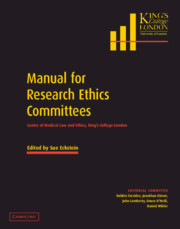Book contents
- Frontmatter
- Contents
- Editorial board
- Acknowledgements
- List of contributors
- Introduction
- Part I
- 1 The ethics of clinical research
- 2 Research ethics committees and the law
- 3 The regulation of medical research: a historical overview
- 4 The regulation of medical research in the UK
- 5 Observational and epidemiological research
- 6 Social survey research
- 7 Approaching qualitative research
- 8 Complementary and alternative medicine: challenges for research ethics committees
- 9 The ethical review of student research in the context of the governance arrangements for research ethics committees
- 10 The ethics of genetic research
- 11 Research or audit?
- 12 Randomised controlled trials
- 13 Determining the study size
- 14 Risk assessment for research participants
- 15 Absorbed radiation in patient and volunteer studies submitted to the ethical committee: a memorandum
- 16 A guide to the use of radioactive materials and radiological procedures for research purposes
- 17 Indemnity in medical research
- 18 The prevention and management of fraud and misconduct: the role of the LREC
- 19 Understanding clinical trials: a model for providing information to potential participants
- 20 The law relating to consent
- 21 Writing information for potential research participants
- 22 The law relating to confidentiality
- 23 Research involving vulnerable participants: some ethical issues
- 24 The ethics of research related to healthcare in developing countries
- Part II
- Index
8 - Complementary and alternative medicine: challenges for research ethics committees
Published online by Cambridge University Press: 08 January 2010
- Frontmatter
- Contents
- Editorial board
- Acknowledgements
- List of contributors
- Introduction
- Part I
- 1 The ethics of clinical research
- 2 Research ethics committees and the law
- 3 The regulation of medical research: a historical overview
- 4 The regulation of medical research in the UK
- 5 Observational and epidemiological research
- 6 Social survey research
- 7 Approaching qualitative research
- 8 Complementary and alternative medicine: challenges for research ethics committees
- 9 The ethical review of student research in the context of the governance arrangements for research ethics committees
- 10 The ethics of genetic research
- 11 Research or audit?
- 12 Randomised controlled trials
- 13 Determining the study size
- 14 Risk assessment for research participants
- 15 Absorbed radiation in patient and volunteer studies submitted to the ethical committee: a memorandum
- 16 A guide to the use of radioactive materials and radiological procedures for research purposes
- 17 Indemnity in medical research
- 18 The prevention and management of fraud and misconduct: the role of the LREC
- 19 Understanding clinical trials: a model for providing information to potential participants
- 20 The law relating to consent
- 21 Writing information for potential research participants
- 22 The law relating to confidentiality
- 23 Research involving vulnerable participants: some ethical issues
- 24 The ethics of research related to healthcare in developing countries
- Part II
- Index
Summary
Introduction
Within the last 30 years, there has been a huge growth in usage of complementary and alternative therapies (CAM) both in the UK and world wide (Eisenberg et al., 1998). A report to the Department of Health estimated that up to 5 million patients in the UK may have consulted a CAM practitioner in the preceding year (Mills and Budd, 2000) and a recent Report by the House of Lords Select Committee on science and technology recognised that use of CAM in the UK is wide spread and growing (House of Lords, 2000).
Whereas in the past, orthodox medicine was hostile to wards CAM approaches, doctors are increasingly interested in the potential benefits CAM may offer their patients, particular those patients suffering from chronic, un differentiated diseases for which conventional medicine has little to offer. A 1995 study estimated that 39.5% of GP practices in England were providing access to CAM the rapists for their NHS patients (Thomas et al., 1995). A recent survey of UK GPs carried out by the BMA (BMA, 2000) found that 79% of those responding felt that acupuncture should be made available to patients on the NHS. The most popular therapies currently are the so-called ‘big five’, namely: acupuncture, homoeopathy, herbalism, osteopathy and chiropractic (the last two of which are subject to statutory regulation). Other popular therapies include aromatherapy, reflexology and healing. Most consultations with CAM practitioners occur in the private sector, with patients paying for sessions out of their own pockets. Most CAM practitioners are not medically qualified, although growing numbers of doctors, nurses, midwives and physiotherapists also utilise CAM techniques.
- Type
- Chapter
- Information
- Manual for Research Ethics CommitteesCentre of Medical Law and Ethics, King's College London, pp. 49 - 52Publisher: Cambridge University PressPrint publication year: 2003



